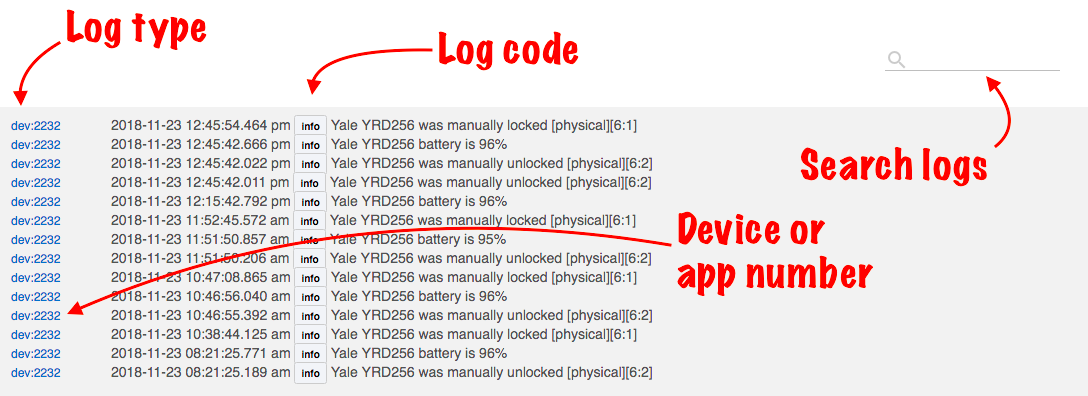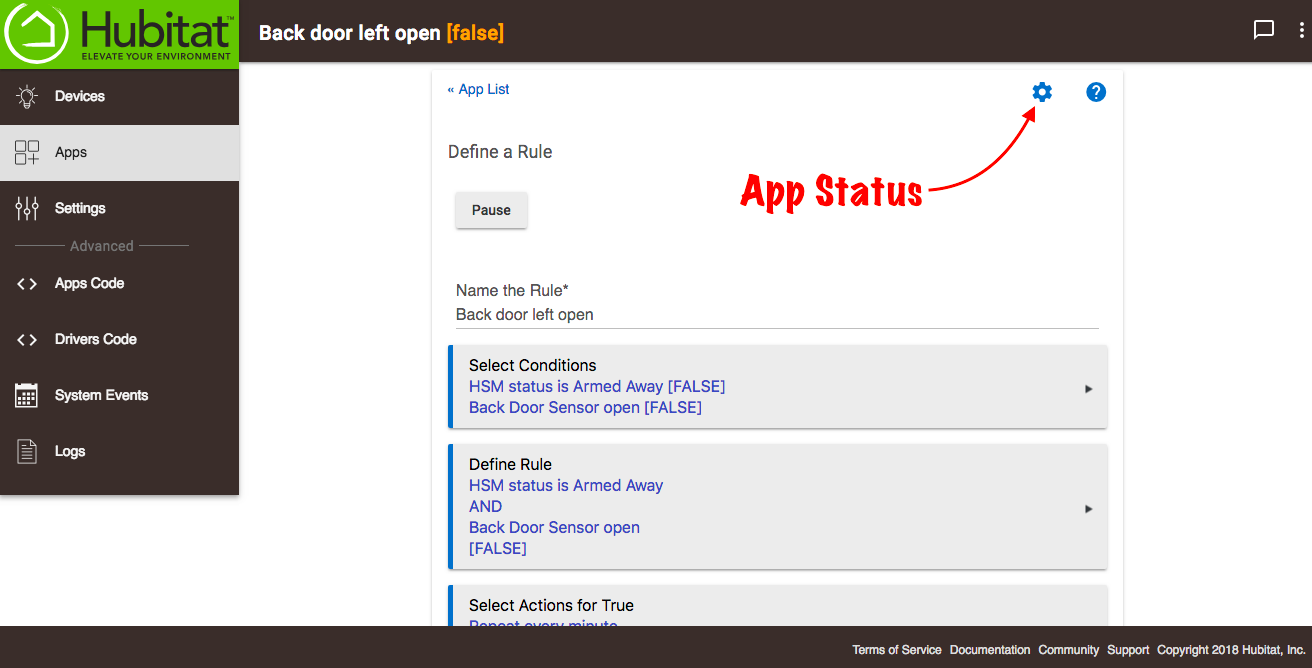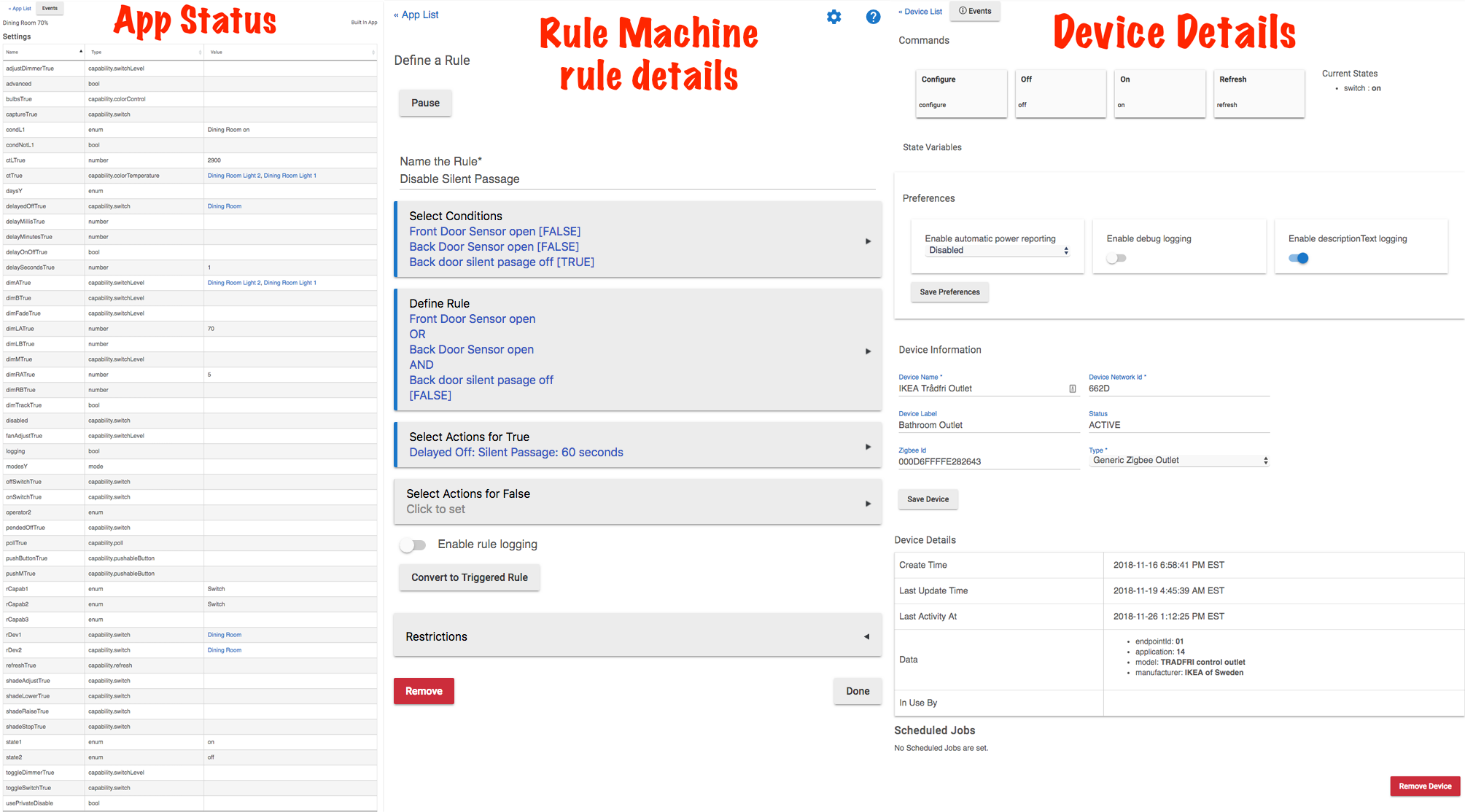How to collect information for support
To provide you with timely support, it is necessary to gather and submit information to the Hubitat support team. Please help us assist you by copying logs and capturing screenshots of driver and app pages that are related to, or are suspected to be related to the issue.
Contents
Logs
For detailed information about the Hubitat Logs page, please refer to the Logs documentation.
Anatomy of Hubitat Logs
Many issues with devices and app code can be identified by using Logs in your Hubitat Web Interface. Examining your logs can save you a lot of time and frustration by quickly pinpointing the line of code in the device or app that is generating an error.
Open your logs by selecting Logs on the left side of your Hubitat Web Interface. If you have devices connected and active, you should start seeing log details appear as those devices check in with the hub.
Each log will have at least one of five codes:
Trace, Debug, Warn and Info logs display routine messages from properly functioning devices or apps. Red Error messages are of concern and should be given special attention..
If you notice Error in your logs, it will be followed by additional information to help diagnose the issue. Pay close attention to Error logs that show “no method exists” or “caught exception”
.
The affected device or app code will be listed on the left side.
Error logs will also show which line of code is generating the specific error. If the error is in a custom driver or app, the Error Type can give you clues to assist in debugging the code yourself or contact the app developer with this information. You may use the Search to find specific log codes, dates, times or other information.
NOTE: If you encounter errors from a built-in app or driver, please ensure you contact the Hubitat Elevation™ support team.
Capturing log files
To capture log files you can highlight, copy and paste the log entries in an email or take a screenshot and send it as an email attachment to the Hubitat support team. Please do not take photos of screens with the camera of another device. This is often does not provide a high enough resolution image to see all the detailed information captured in the logs.
Logs are only capture in the main log window when it is open, therefore it is necessary keep it open in another tab or browser window to capture current logs. You may obtain log data from the Past Logs, by selecting the Show Past Logs button, but they are stored in a limited buffer that will purge the oldest logs when full. Past Logs may not always contain the range of information required to support your particular issue.
Isolating log files
When you open your Hubitat Logs, it will default to All log files, which is a combined view of the logs from all Hubitat apps and drivers. While this is convenient to quickly view if errors or warnings are appearing in the logs, it may not show enough information to help support troubleshoot the issue you are experiencing. Here's how to isolate the logs from a specific driver or app.
Driver logs
- Ensure Enable debug logging is switched on in the driver settings and select Save Preferences, or when available, configure the logging details in the app.
- Open the Hubitat Logs in a new browser tab or window.
- Leaving the logs open, return to the driver window
- For driver debug logging, tap the ON, OFF, Lock, Unlock or other button in the driver to make it generate log results. Typically support will instruct you what to operate in a driver details page to generate required logs. This may include tasks such as manually operating a device or triggering a sensor. When specific information is required, you'll receive instruction from support.
- Return to the logs page you left open in the separate tab or window, then tap or click on the specific driver or app name and then select the Clear button.
- Wait for the logging information for an app to appear. In the case of a driver, return to the driver details page and tap the required buttons to generate the type of debug logging information needed for Hubitat support to assist with your particular issue.
Capturing screenshots
Multi-platform
Full screen capture is easily obtained by using a plugin for your browser. This quickly captures all the information on screen that would normally requires scrolling and multiple screenshots in order to provide support with everything needed. One of the simplest to use is named Full Page Screen Capture for Google Chrome.
Windows
- Use the key PrtScn (Print Screen) or CTRL + PrtScn. Windows creates a screenshot of the whole screen and stores it in the clipboard. Paste the image (CTRL + V) into Paint, and image editor or Wordpad. Save the file for upload to Hubitat support. Note: If you have a laptop keyboard, it may be necessary to also hold down the Fn key in order to capture a screenshot.
- Hold down Alt and then press PrtScn. (Alt + PrtScn) to capture just the active window and store it in the clipboard. Paste the image (CTRL + V) into Paint, an image editor or Wordpad. Save the file for upload to Hubitat support. Note: If you have a laptop keyboard, it may be necessary to also hold down the Fn key in order to capture a screenshot.
- If you use Windows 10, press the Windows key + Shift + S to capture a region of your screen and store it in your clipboard. After you press Windows key + Shift + S, the screen is dimmed, and a crosshair is shown. Press the left-click mouse button, draw the area that you want to capture and release the mouse button. If you have a touchscreen, draw the area that you want to capture with your finger (or pen) on the screen. The image will be stored in the clipboard. Paste the image (CTRL + V) into Paint, an image editor or Wordpad. Save the file for upload to Hubitat support. Note: If you have a laptop keyboard, it may be necessary to also hold down the Fn key in order to capture a screenshot.
- To take screenshots on a Surface tablet or any other Windows tablet without a keyboard, you can take full-screen screenshots by pressing the Windows logo and the Volume Down key at the same time. You will see the screen getting darker when you do this, indicating that a screenshot was made. You will find the screenshot in your Pictures library for upload to Hubitat support.
Windows Surface Pro
If you have a Surface Pro tablet from Microsoft with Windows 10, you need to use different keyboard shortcuts, because there is no PrtScn key on the Type Cover. Instead, Microsoft offers the following Surface-device specific shortcuts for Windows 10:
- Fn + Spacebar - this shortcut stores an image of your current screen in the clipboard. Paste the image (CTRL + V) into Paint, an image editor or Wordpad. Save the file for upload to Hubitat support.
- Fn + Alt + Spacebar - this shortcut stores a screenshot of the active window in the clipboard. Paste the image (CTRL + V) into Paint, an image editor or Wordpad. Save the file for upload to Hubitat support.
Windows Screen Capture apps
- Use can also use the Snipping Tool. Search for the words "snipping tool" in the Start Menu search box (if you use Windows 10 or Windows 7) or on the Start screen (if you use Windows 8.1) and click or tap on the appropriate search result. Capture the screen shot for upload to Hubitat support.
- Use the Snip & Sketch app (Windows 10 only) Starting with the October 2018 Update, Windows 10 has a new app that is meant to replace the Snipping Tool, but you may still have both. Use Snip & Sketch to capture the screen shot for upload to Hubitat support.
Apple MacOS
- To capture full screen on Macintosh, hold down the Command, Option and Shift keys together and press 3 (⌘ + ⌥ + ⇧ + 3). The resulting PNG file name will be Screenshot with the date and time, and it will be saved to your desktop for upload to Hubitat support.
- To capture a specific area on Macintosh, hold down Command, Option and Shift keys together and press 4 (⌘ + ⌥ + ⇧ + 4). The cursor will change to a crosshair. Click, hold and drag across the area you wish to capture, releasing to complete the capture. The resulting PNG file name will be Screenshot with the date and time, and it will be saved to your desktop for upload to Hubitat support.
Android phones and tablets
- To capture screen shots on Andriod devices, press the volume down button and the power button simultaneously. Resulting screen shots will be saved in the Gallery app under Screenshots for upload to Hubitat support.
Amazon Fire tablets
- To capture screenshots on Amazon Fire tablets, press the volume down button and the power button simultaneously. Resulting screenshots will be saved in the Amazon Photos app for upload to Hubitat support.
Apple iOS devices
To capture screenshots on iOS devices, there are two different methods, depending on whether or not your device has a Home button.
- For iOS devices with a home button, simultaneously press the home and power buttons. The resulting screenshot will be saved to the Photos app for upload to Hubitat Support.
- iOS devices that do not have a home button require you hold the Side button on the right of your device and then immediately press the volume up button on the left side. The resulting screenshot will be saved to the Photos app for upload to Hubitat support.
Screenshot examples
To get to the App Status page, select the gear icon at the top right of your Rule Machine® rule, or other app
Submitting support requests
In order to best assist you with the issue you are experiencing, please first try substituting any custom drivers with virtual drivers to see if the behavior can be reproduced.
Using Rule Machine® or other built-in apps, and temporarily removing custom apps will help to establish a baseline for testing. Once the custom drivers and apps have been substituted for built-in drivers and apps, test your system to see if the issue persists. If your hub is still not performing as expected, escalate the problem to our support team.
Please include the following in support requests
- Your hub platform version.
- A detailed description of the issue and expected result.
- Driver debug logs and application logs - Isolated to the specific device or application that is suspected.
- Screenshots of associated Rule Machine® rule details, Device Detail and App Status.
NOTE: For Rule Machine® specific support requests, please also include a brief description of what you want to accomplish with your rule. Please be as detailed as possible.
If removing the custom driver or app solves the issue, the problem is with the custom code. We do not support custom code, but encourage you find the source of the problem and reach out to the developer directly. To find the code that is responsible for the issues you have been experiencing, add your custom drivers and apps back into your system one at a time, testing your system each time you add a custom driver or app. Once you pinpoint the driver or app code that is causing the issue, please contact the developer in order to resolve it. You can also post in the community to help others who may be experiencing similar issues.




